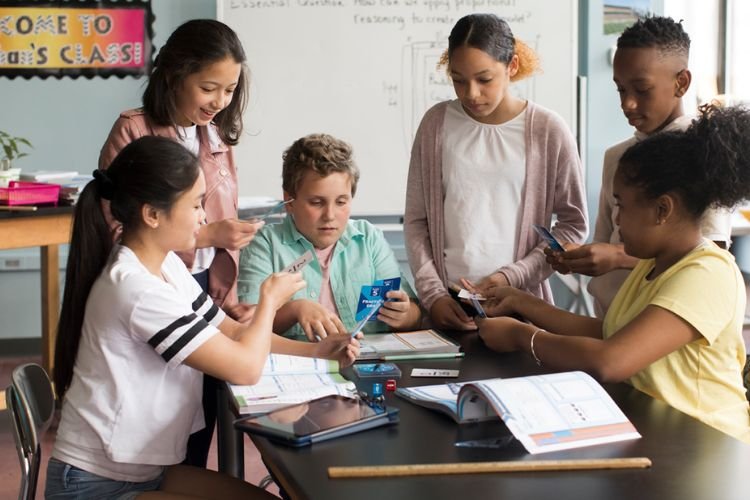![]()
Aren’t we always delighted to study with friends? Be it school or be it college, friends have played a pivoting role in our academics. This, in formal terms, is called collaborative learning. It is a significant aspect of modern education as it helps make the same teaching and learning process more fun and creative.
Let’s dive a little deeper and look at it from the standpoint of school education.
What is Collaborative Learning?

Collaborative learning refers to enhancing the teaching-learning process through teams or small groups. This process involves two or more than two students working together to solve a problem and learn new concepts.
It is an engaging process where the learners bounce ideas off of each other, explain concepts to each other, and learn by doing and experiencing.
How Collaborative Learning Benefits Students

So what makes collaborative learning an unavoidable aspect of modern education? Check out the top benefits of collaborative education.
Research shows that students learn more when their learning is active, social, contextual, interesting, and their own. Some of the perks of learning together are:
- Higher-level thinking, speaking, self-management, and leading skills will be taught.
- Encourage contact between students and teachers.
- Student retention, self-esteem, and duty will all go up.
- Being exposed to and learning more about different points of view.
- Preparation for social and work events in the real world.
Also Read: How to Develop Student’s Social Skills?
Effective Collaborative Learning Techniques
Collaborative learning techniques encourage students to work together in groups or pairs to achieve a common learning goal. These techniques can foster active engagement, critical thinking, communication skills, and a deeper understanding of the material.
Group discussions involve the division of students into smaller groups for the purpose of engaging in discourse centered around a particular topic or question. This practice fosters the facilitation of intellectual discourse and enables students to engage in the exploration of diverse viewpoints.
Peer teaching is a pedagogical approach wherein students engage in the process of instructing their fellow classmates on a particular subject or concept, with each student assuming the role of a teacher in a rotational manner. This technique enhances individuals’ comprehension of the subject matter and provides them with exposure to diverse pedagogical approaches and explanations.
Collaborative writing entails the collective effort of students in the creation of written assignments or reports. Academic writing encompasses several forms of collaborative writing, such as group essays, research papers, or collaborative wikis. The aforementioned practice fosters collaboration and collective accountability towards the ultimate outcome.
The classroom is organized into teams with contrasting perspectives, and students participate in formalized arguments. This practice promotes the development of critical thinking skills, the ability to conduct thorough research, and the capacity to construct As finals week approaches, you’ve likely been contemplating the best way to organize an effective study group for those upcoming challenging exams. Here are some tips to facilitate a more productive study session:
How to Form Effective Study Groups?

The effectiveness of a study group hinges on the commitment of its members to achieving good grades. Ideally, a study group should consist of three to five dedicated individuals who convene for one to three hours. Sessions under an hour tend to be rushed, while overly extended sessions may lead to decreased productivity and loss of focus.
- Preparation is Key: Each member should come to the group well-prepared. Prior to the session, familiarize yourself with the material and pinpoint areas where you’re encountering difficulties.
- Maintain Organization and Focus: Although it may sound straightforward, staying organized and focused can be challenging within a group dynamic. Designate a group leader, often the one who initiated the study session, to guide the session. Study with friends to enhance collaborative learning.
- Choosing a Session Format: A structured approach significantly enhances the effectiveness of a study group session. Decide in advance what topics you plan to cover and in what order. Consider these format options.
What are The Fun Elements in Collaborative Learning?
Collaborative learning is enriched by various engaging elements that foster a dynamic and interactive educational experience.
- Gamification and competition: It adds excitement and motivation and fosters a spirit of camaraderie among learners.
- Creative projects and presentations: Encourage hands-on exploration and allow practical application of knowledge.
- Humor and creativity: Involve an enjoyable element into learning and make concepts more memorable and relatable by Incorporating technology and multimedia.
- Overall Impact : Enhance collaborative learning for effective knowledge acquisition and skill development.
What is the Impact Of Technology on Collaborative Learning?
In today’s education, students work together using technology rather than always studying alone. The Collaborative aspect focuses on how technology helps students collaborate with classmates and experts outside of school. This helps create a lively learning environment and teaches students teamwork, which is important in the real world. Using technology for collaboration makes education more interactive and helps students improve their thinking and communication skills, as well as their ability to work together online.
Wind Up
Collaborative Learning in modern education is about students working together to learn and solve problems. It helps them understand concepts better and improves their thinking and communication skills. Technology also plays a big role in making learning more interactive. Embracing collaborative learning prepares students for real-world situations and promotes a sense of teamwork. As education advances, collaborative learning remains an important and effective way for students to learn , have fun and grow together.
Also Read: What is STEM Education? How is Important?








